A trip to Laos is nothing short of a meditative experience and the monuments of Laos are worth visiting. Life moves mindfully, the cuisine is soulful and the ambience is pure bliss. Monuments, caves, forests, mountains, adventure sports and waterfalls are some of the unique features of a holiday in Laos. The country is home to around 49 ethnic groups and has a wild terrain. Laos can be visited anytime because the climate is tropical throughout the year. Here are some of the historic monuments in Laos on your trip:
List of Monuments in Laos
1. Buddha Park
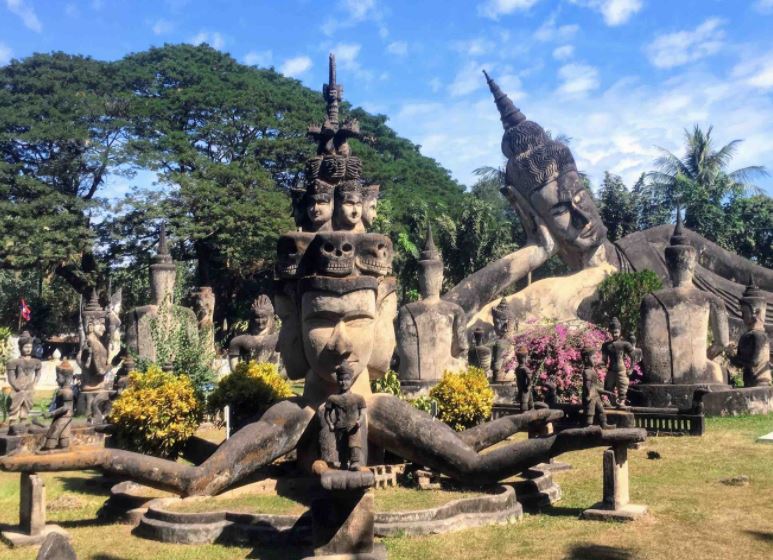
Buddha Park
Buddha Park is a sculpture garden housing Hindu sculptures and a collection of Buddhist in a park-like setting on the banks of the Mekong river outside Vientiane. The park, also known as Xieng Khouang Buddha Park and Xieng Khuan was built in 1958 by Luang Pu Bounleua Sulilat, a Laos citizen who later moved to Thailand where he built a similar park named Sala Keoku in Nong Khai, on the other side of the Mekong river. Buddha Park is not a temple, even though some of its sculptures like a large reclining Buddha are worshipped by local Buddhists although often referred to as Wat Xieng Kane (Wat meaning temple).
Sculptures of the Hindu Gods, demons, mythological creatures and Buddha. The park houses over 200 sculptures made from concrete in varying sizes from small to very large. The sculptures of the several Hindu Gods, Buddha, mythological creatures like a three headed elephant and demons are pretty weathered, giving them an impression of being old.
One of the most striking sculptures is with three floors a giant pumpkin. Its open mouth serving as the entrance, at the front is a large mythological creature. Its three floors represent Hell, Earth and Heaven.
Unfortunately, there are very few signs in English with information about the
sculptures and their meaning. This beautiful monument in Laos is housed in a park-like setting with lots of trees and good views of the Mekong river. On the grounds are food vendors, a gift shop and a restaurant overlooking the Mekong river. About 25 kilometers South East of Vientiane on the banks of the Mekong river, Buddha Park is located near Thadeua Village, just past the Thai Laos friendship bridge there are several ways to get there. The easiest way is to book with a Vientiane travel agent.
Address: Thanon Tha Deua, Vientiane Laos.
2. Patuxai Victory Monument

Patuxai Victory Monument
Patuxai Victory monument is considered as the triumph symbol of the Lao. It lies at the end of Lan Xang Boulevard or Thanon Luang Avenue in northeastern Vientiane which is a monument of Lao victory. Most tourists visiting the capital of Laos are spending time visiting Patuxai Victory Monument, which is considered the symbol of the city. This monument was constructed to honor the soldiers during French war against the French of the Lao people. Patuxai is located between the main street of the most beautiful street in the capital, wherever you go from any direction can recognize it from afar.
In the middle of the intersection of the streets, Patuxai welcomes the dawn of a new day and it is also the place to watch clear sunset at night. Through many times unfinished due to lack of funding and many other reasons, so far Patuxai Victory monument has not really accomplished. For the people of Laos, this construction is not continued because it represents a part of the country’s poor history. This site is known as a message so that the future generations understand the difficult past to strive to build country in the future. If you follow the spiral staircase, you will come to the 7th floor of the tower. The vast space and wide reach of all directions of the capital Vientiane appear in front of visitors.
At the town hall, Pha That Luang (World Cultural Heritage, the national symbol of Lao PDR), the largest market in Vientiane, morning Market … all can be seen from Patuxai. This is a great place to take pictures of the city. Although retaining the cool look of the cement, this national monument in Laos is combined harmoniously in a large and lovely square. When the sun is fading, the Vientiane people gather here. Families walk, children play, the elderly enthusiastic exercise, some couples look at the cool lake together. Patuxai is a great and friendly space of friendly Lao people.
Address: Patuxai, Vientiane, Laos.
Visit: Famous Monuments in Agra
3. That Dam (Black Stupa)

That Dam (Black Stupa)
Also known as the Black Stupa, it is a 16th-century Buddhist stupa in central Vientiane. This famous monument in Laos is located on a roundabout not far from Talat Sao (morning market) and the American Embassy. Locals believe that a 7-headed water serpent – Naga – lived here to protect the stupa, which was once covered in pure gold. The gold was pillaged and taken to Siam during the Siamese-Laotian war in the late-1820s and leaving the legacy that is the black stupa today. Place is not so obvious but can be easily found. You can sit for a while under the Stupa if you wish because there are some benches for sitting.
Legend, folklore, and history are all combined to make this amazing monument a charming and curious place to visit. The stupa’s lack of refurbishment makes for a refreshing change from most religious sites in nearby countries such as Thailand, where stupas and temples are endlessly renovated and rebuilt. When the ancient site is illuminated in colourful artificial lighting, then visit Dam in the late evening. You can even enjoy the view from most bars and restaurants surrounding the stupa.
Address: Chantha Khoumane Road, Vientiane, Laos.
4. Pha That Luang
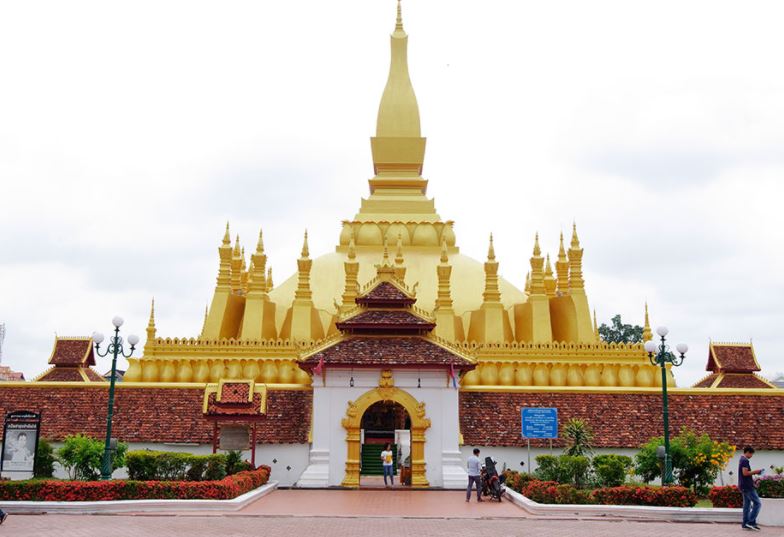
Pha That Luang
Pha That Luang, also known as the Great Golden Stupa, is considered the most significant national symbol and sacred monument in Laos sovereignty. Located in the outskirts of Vientiane city, the first impression about Pha That Luang must be the glorious splendor of this huge Buddhist Stupa covered in gold. The unique architecture and the ancient religious structure help the Great Stupa become a monument of national pride that every Indochina traveler shouldn’t miss. Originally, the Great Stupa was built as a Hindu temple in the 1st century then was rebuilt as a Khmer temple in the 13th century.
The current structure was constructed by the order of King Setthathirat in 1566 after relocating the capital from Luang Prabang to Vientiane. As an eye-witness of Lao history, Pha That Luang had undergone several major reconstructions over the years due to the plunder of foreign invasion. Significantly, the Kingdom of Siam repeatedly caused severe damage to the Great Stupa from the early 19th century to the year of 1940. However, it was not until the end of World War II that the Stupa was completely rebuilt by the design of a French architect.
Becoming a symbol of Lao national pride, Pha That Luang has references to Lao culture and identity. The main stupa is designed in a pyramid shape which is approximately 69 meters long and 45 meters high. The Stupa is decorated with 500 kilos of gold leaf which makes the shining structure a stunningly precious look. Surrounding the Great Stupa, there are large grounds consisting of gardens, temples, monuments and a Palace, where monks still live and study. It is worth taking a stroll through the cloister to contemplate the paintings, sculptures and statues of the Buddha. There are also numerous altars at the foot of Pha That Luang, where many people bring gifts and flowers to give respect to the Stupa.
Address: Pha That Luang, That Luang Road, Vientiane 0100 Laos.
5. Wat Sisaket Temple
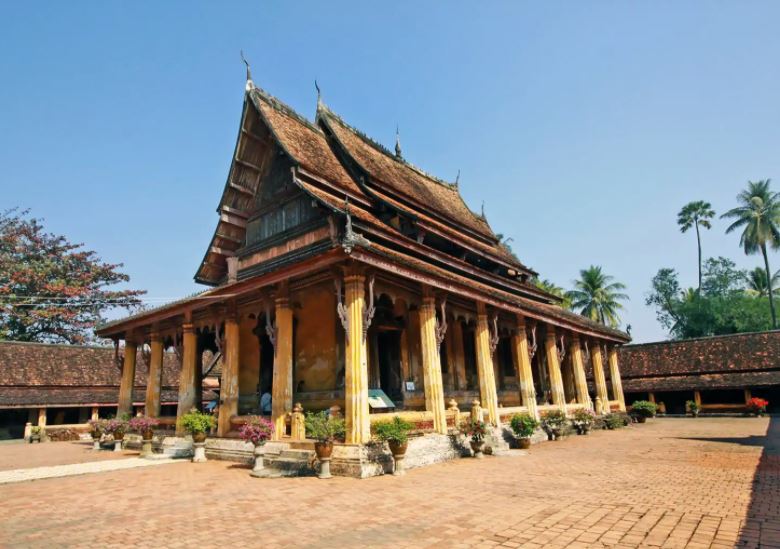
Wat Sisaket Temple
Wat Sisaket Temple, also known as Sisaket, is considered as the oldest temple in Vientiane capital city . It was built on the opposite side of the Presidential Palace by King Chao Anuvong – the last king of Lan Xang Kingdom. Even the temple was built in 1818; it still looks newer than its appearance. Unlike the most other pagodas in Laos, Sisaket Temple has an architecture of Siamese. Its reputation for the collection of more than 2000 beautiful tiny Buddha statues mainly dated from 16th to 19th century with different sizes and materials might be a unique stress.
Besides the collection of tiny Buddha statues, you might be attracted by other interesting items such as: a lovely surrounding veranda, a drum tower, a small library building with a Burmese-style roof, an ornate five-tiered roof and the flowered ceiling of the ordination hall. If you are about to visit Wat Sisaket Temple, the best time to visit is the morning with many activities, for instance praying, offering food to the monks. This religious monument in Laos is truly an incredible experience to know more about Buddhism and Lao’s region as well.
Address: Wat Sisaket Temple, Vientiane, Laos.
Read More: Monuments in Hungary
6. Plain of Jars
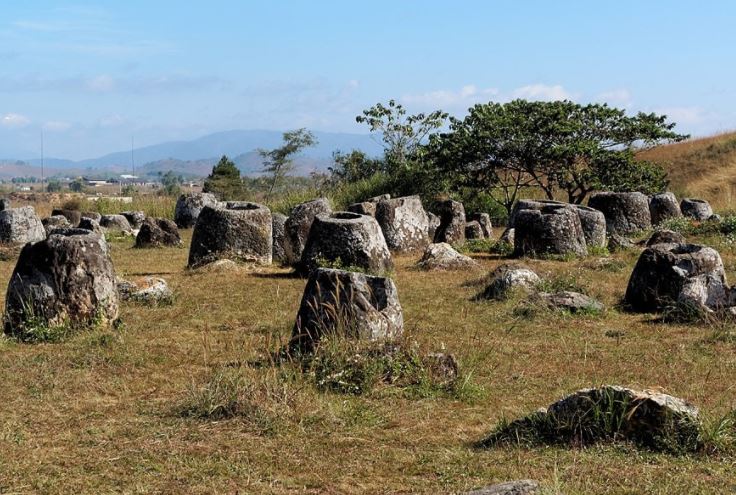
Plain of Jars
The Plain of Jars is one of Southeast Asia’s most misunderstood and mysterious prehistoric places located in central Laos. Each stone jars weighing several tons, approximately ninety sites scattered across many miles of rolling landscape contain thousands of large stone jars. Over 3,000 jars scattered across 90 sites thus far, the archaeologist Julie Van Den Bergh has counted. Each jar weighs several tons and is up to 3 meters tall, often made of sandstone, but also of harder granite and limestone. Several diverse theories exist regarding the uses of the jars — one claiming that the jars were used to collect rainwater during monsoon season.
Laos intends to turn the Plain of Jars into a UNESCO World Heritage Site, once the threat of unexploded objects is minimized.
This old monument in Laos can be extremely dangerous if you step off the beaten track so be careful when enjoying this serene landscape and when walking between the jar sites be aware to stick to well-worn and marked paths.
Address: Plain of Jars, Phonsavan, Laos.
7. Luang Prabang
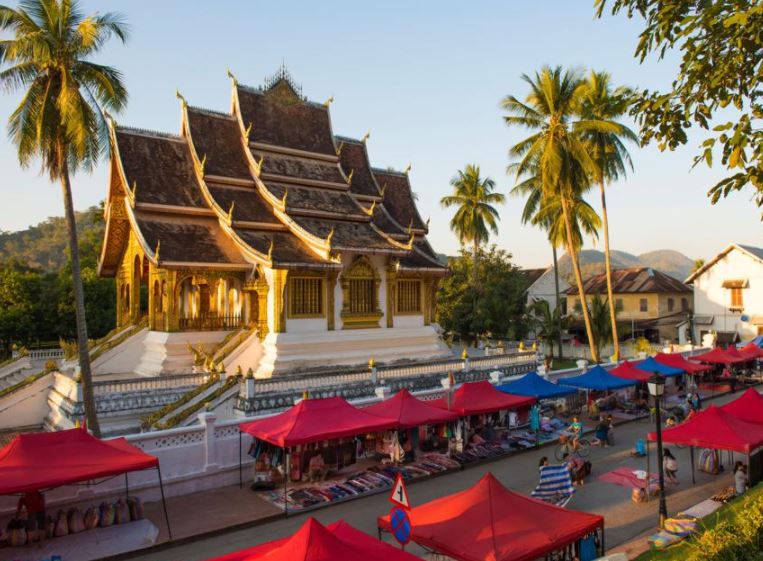
Luang Prabang
The delightful city of Luang Prabang (once the capital of Laos) is considered to be the spiritual heart of the country. Blending a rich meld of Indochina and French architecture, the area is an outstanding example of the fusion between Lao urban structures and traditional architecture that was built in the 19th centuries by the European colonial authorities. The incredibly well preserved townscape earned its reputation as a UNESCO World Heritage site in 1995 and illustrates a key combination of two distinct cultural traditions.
The tiny town sits 700 meters above sea level at the confluence of the Nam Khan and Mekong Rivers and is encircled by mountains. It does attract tourists and consequently higher prices than anywhere else in Vientiane arguably Southeast Asia’s most beautiful spot. The most popular attractions of the area include Wat Xieng Thong temple Kuang Si Falls, Pak Ou Caves, and the Haw Kham Royal Palace Museum.
The city is also well known for the large number of monasteries and Wats means Buddhist temples. Be sure to see here in this ancient monument in Laos the hundreds of monks from the various monasteries who walk through the streets every morning collecting alms.
Address: Luang Prabang, Laos.
Discover: Why Agra is Famous
So far we have discussed the best monuments in Laos, which contains the proper information regarding all the most visited monuments in Laos. I hope you might have loved reading this article and if you love to know more about Laos then kindly head to our other articles as well which will help you to get knowledge about.
The post Most Visited Monuments in Laos l Famous Monuments in Laos appeared first on World Tour & Travel Guide, Get Travel Tips, Information, Discover Travel Destination | Adequate Travel.